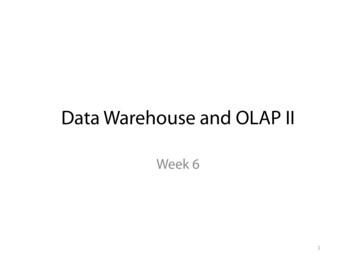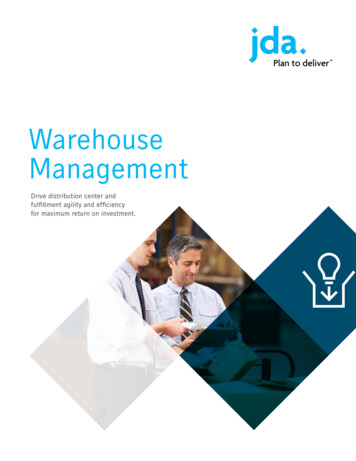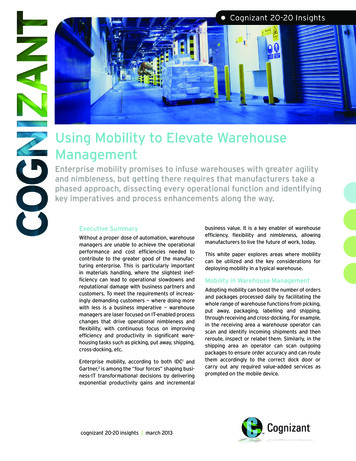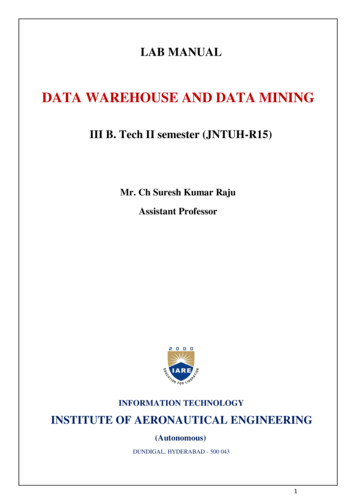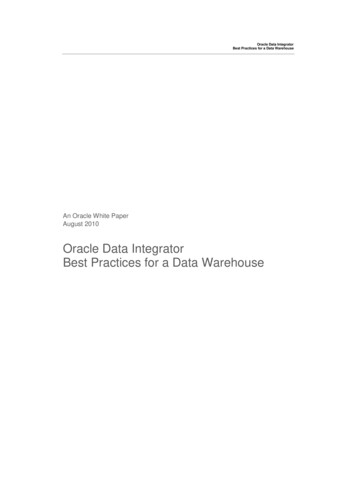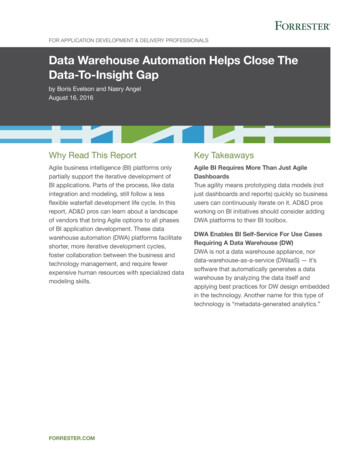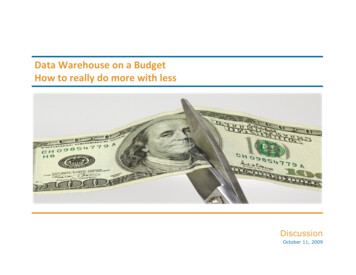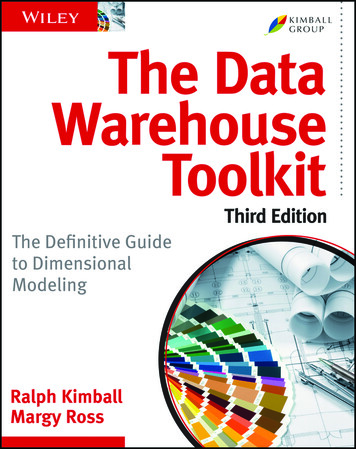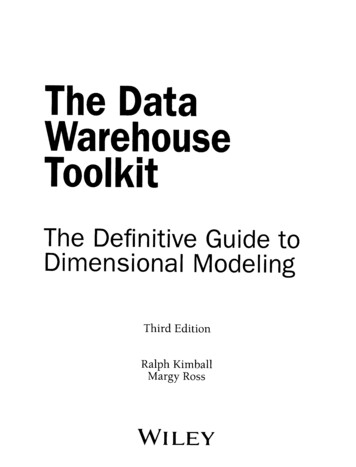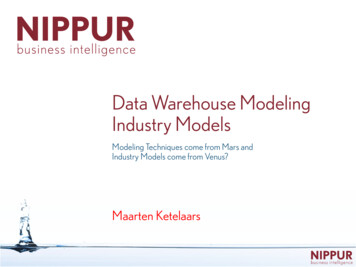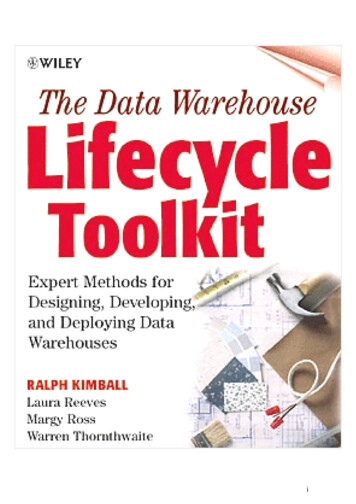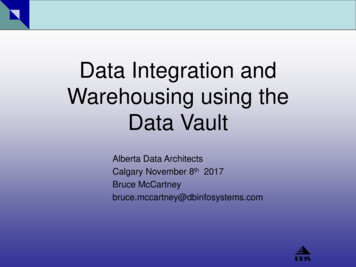
Transcription
Data Integration andWarehousing using theData VaultAlberta Data ArchitectsCalgary November 8th 2017Bruce McCartneybruce.mccartney@dbinfosystems.comDBIS
Agenda Introduction– about me– What is the Data Vault? The Business Problem – challenge in getting data right Enter the Data Vault– What is a Data Vault, really?– When do you use a Data Vault?– Introduction to Key Concepts The Business Solution– Challenges revisitedDBIS
Introduction – About meEvolution of Bruce’s merDBADV CertificationDataArchitectArchitectDV2.0 InstructorDBIS
What is a Data Vault? According to Data Vault Inventor (Dan Linstedt)– DV 1.0 - A Modeling approach “A detail oriented, historical tracking and uniquely linked set ofnormalized tables that support one or more functional areas ofbusiness.”– DV 2.0 now include complete Architectural Blueprint andMethodology “A System of Business Intelligence containing the necessarycomponents needed to accomplish enterprise vision in DataWarehousing and Information Delivery.”DBIS
When do you use a Data Vault? Enterprise Data Warehouse (Inmon or Kimball Style) Bill Inmon: “The Data Vault is the optimal choice for modeling theEDW in the DW 2.0 framework” Kimball – Persistent Staging Area Data Integration/Migration Projects Merger/Acquisitions requiring data alignment Data migration projects – upgrades/migrations Master data management initiativesDBIS
Challenges in Data Architecture Getting data right – “the truth”Integration of data (rather than applications)Compliance/AuditabilityModeling ParadigmAgilityDBIS
The Truth- Your Business Rules There is no truth, only facts as they wereat the time–Truth is subjective and changesover time with the application ofbusiness rulesTwo people can look at the exact samesituation and come up with completelydifferent ‘truths’“We have come to trust ourscreens”(Future Crimes by MarcGoodman)Closer Facts Information– Less “technical debt” resultingMore data – less rules–––IOT, Internet, Automation, AI and deep learningRise of the Robots – Martin FordMonkeylearn Taxonomy ling-next-job-replaced-ai-ronald-kunenborg/DBIS
Integration – Big Data Internet of se/2014iview/executive-summary.htm 4 “V”s of Big Data volume, variety, velocity, and veracityDBIS
Data Integration “Business Key” Alignment––––Unique? global?Use of “smart keys”Multiple systems carry different and same parts of data objectsCross platform integration Timing – dependencies– Where to put you business rules -conforming– Optimize Business Cycles– Global Enterprises 24x7 Integration in real time EAI vs. EII Architecture– Are we integrating process or data?DBIS
Compliance and Auditability Prove the information is the facts as they were with businessrules applied Dataucracy – data lakes, data governance, data qualityDATAUCRACYDBIS
Data Scientist’s Dirty BIS
Data Scientist’s 7DBIS
Lack of Agility IT record in data warehousing and integration not good Why?1. ETL eats your lunch (up to 70%)– Business rule applied on the way in to DWH– Think Data Warehouse Automation2. Development Paradigm– Waterfall, Big Bang, Do Over– Lack of Agile BI adoption (Scott Ambler - Discipled Agile Development) Agile BI Manifesto (Agile Analytics Ken ototypes-for-data-warehouse-etl-jobsDBIS
Modeling – Resilient Scalability Needed to Adapt some of these for data warehousing:– 3NF Rework and inflexible– Star Schema Structure Type-2 Dimension Conformance complexity Aggregation and help tables Snowflakes– Anchor Model More tables instead of attributes grouped Lots of material comparing methods for modelling Boils down to “Model last” vs. “Model first”DBIS
Where does the Data Vault fit in? Dan LinstedtDBIS
Data Vault 2.0 Key Concepts KEY CONCEPTS– Data Data separation into business key, relationships and context (ensemble)Immutable raw data (non volatile) – Inmon definition of DWHDecoupled from information created through execution of business rulesFocused on Integration by BK as opposed to “process” orientation– Architecture Layered Logical Architecture – implementation agnostic (relational/BigData)– Methodology Agile Build (incremental, automatable approach)DBIS
Data Vault Model Concepts Everything is MANY-TO-MANYTime dependency on everythingUses Relational DBMS – can extend to NOSQLLate BINDING for data – the LINK– Closer alignment to schema-on-readOracle – Information management and big data reference architectureDBIS
Unified DecompositionIn Consolidated Raw database, we load and decompose data into 3 areas.For example TAG:TAGBusiness KeysEngineering DisciplineAssociations or RelationshipsTag Hans Hultgren:https://www.youtube.com/watch?v kRoDRlj8 YUBook: -Vault/dp/061572308XProject Number (FK)Document Number (FK)Equipment (FK)18DBIS
Data Vault Model Components “Table types”: Hub List of business keys Satellite Time dependent descriptive Information Link Describes relationship between business keys Raw and Enriched data– Raw Data Vault– Business VaultDBIS
Case Study Business Problem Manage “AssetInformation esDBIS
Motivation: The Value ChainDetails OmittedCAN 86M/yrDBIS
Enrichment Database (eDB)DBIS
TAG decomposition completedData is stored in HUBs (Keys), Links (Relationships) and Satellites (Time dependentContext attributes)Source1CERLLCERLLTag DocumentDocumentTAGTag ProjectTag EquipmentSource223ProjectEquipmentDBIS
Data Model – Incremental/Agile buildAdditional Data from logical model added over SATSATDBISSATSATSAT
Goals Program Level– Data consolidation, integration, andenrichment.– 95% automation & accuracy Technical Level– Automate migration build– Automate verification and enrichmentusing rules, and humans as necessary.– Produce enriched data set that isaudible and traceable– Have approach repeatable for the next13 facilities.DBIS
Automate Raw Data Vault Generate DDL andload proceduresusing metadata Excel SQL Serverand TSQLDBIS
Business Vault Use Case Driven “change of data” in raw data vault No requirement to grain shift data– (i.e. normalize, summarize or allocate) “Getting Data Right”– Schema last vs. schema first– Do everything you can automatically – with machinelearning and statistics, ask for help only whennecessary Time required to enrich not a factorDBIS
Business rules engine decision Looked at SSIS DQS, JBOSS,DROOLS, AnalytiX DS, Talend,WhereScape and Tamr Decided to build, due to fundingrestrictions, skill-set, politicalsituation, and agilityDBIS
Tenets of our Business Vault Business vault regeneration possible “at any time”– using business rules valid at that timeBack to the future and forward to the pastDBIS
Tenets of our Business Vault If there is nothing to do, do nothing– Rules run once unless data or rule changed since last run Support for “hard” and “soft” business rules– Hard rule example: Business Key override resulted in SAME-AS Links Provide lineage/auditability for each business rule application– Data Vault gives you this for free. Versions of satellite data taggedwith rule id Failures in validation sent to "work queue" for humananalysis.– Data fix and reprocess; or new transform rule / overrideDBIS
Challenges revisitedWith Data Vault 2.0 :Getting it right – “the truth”,Data Integration,Compliance/Auditability,Resilient, Scalable Modeling, andAgilityare all “baked in” to a recipeDBIS
Getting it right – “the truth” with Data Vault– All we want are the facts, ma’am– Decouple facts (hard rule) from information (soft rules)– Information becomes built for purposeDBIS
Data Integration with Data Vault––––Alignment by Business KeyMaster data management applicationRelational and HadoopIncrementalDBIS
Compliance/Auditability with Data Vault– Built-in features Consistent repeatable, generatable logic Time dependent versions of data Immutable facts– Capabilities possible Rapid rework of informationRegenerate source data at a point in time (best practice for testing)Regenerate information from a point in time with current rulesRegenerate information from a point in time with rules from a point in timeusing a time dependent rules engineDBIS
Modeling with Data Vault––––Decouple data from informationEnsemble hub/spokeIntegration by BKInformation Marts Virtualization Flexibility (Star Schema, Graph, Wide tables)– Resilient ScalabilityDBIS
Agility with Data Vault– Incremental build Maximize work not done– Generation/automation Metadata/model driven Data Warehouse Automation tools– Disciplined Agile Development (http://www.disciplinedagiledelivery.com)DBIS
Conclusion Data Vault is “more better” way to do data warehousing andintegrationDBIS
s://www.linkedin.com/in/mccartneybruce/Google: “Data Vault”Dan’s Warehouse-Vault/dp/0128025107User’s Group:http://www.DataVaultUsersGroup.orgCalgary Meetup Nov up-CalgaryCIPS Calgary BI SIG:http://www.cips.ca/node/3417DBIS
IT record in data warehousing and integration not good Why? 1. ETL eats your lunch (up to 70%) – Business rule applied on the way in to DWH – Think Data Warehouse Automation 2. Development Paradigm – Waterfall, Big Bang, Do Over – Lack of Agile BI adoption (Scott Ambler -
